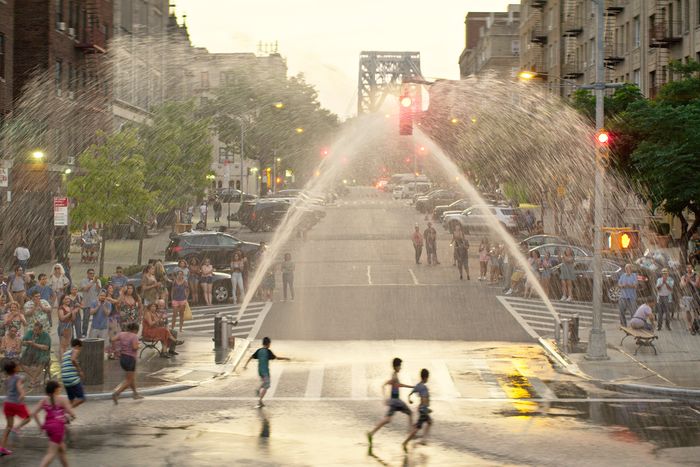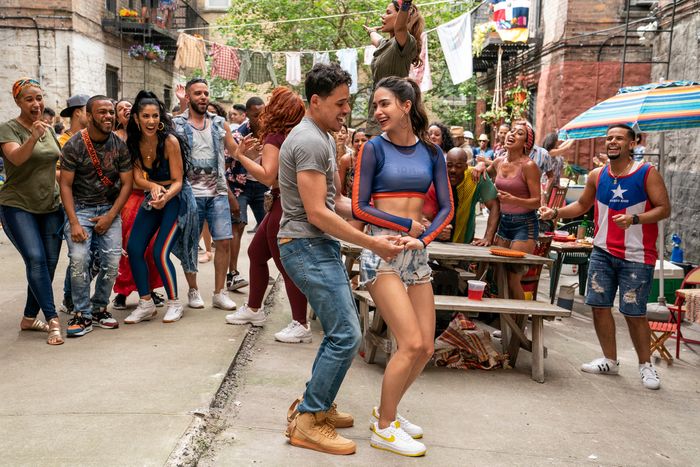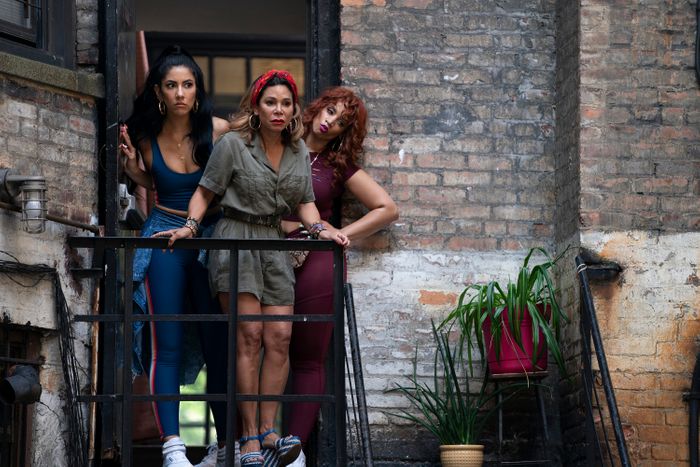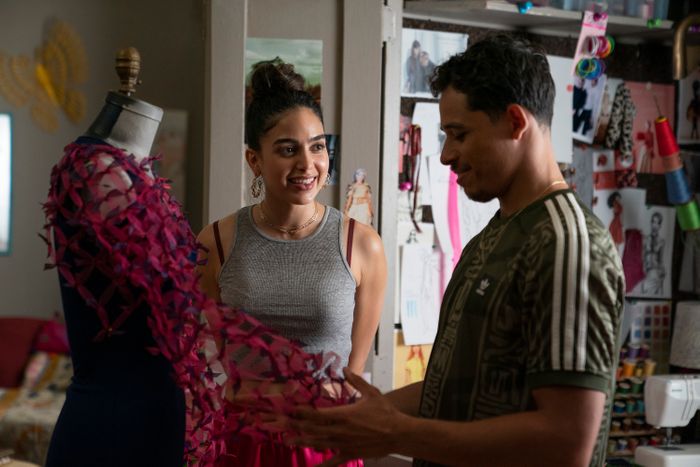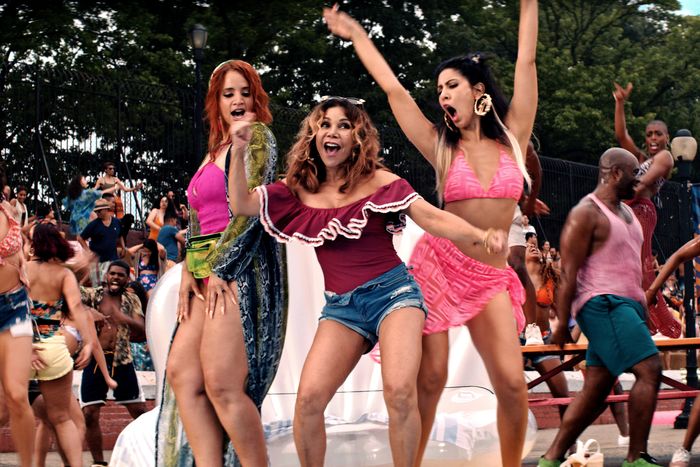
Let’s face it: Summer hadn’t officially kicked off until after In the Heights made its long-awaited debut at the Tribeca Film Festival on June 9 (it arrived in theaters and on HBO Max today, June 10), but Jon M. Chu’s big-screen musical is awash with bold print and color to usher in the hot-weather season. Set during a heatwave, In the Heights is adapted from Lin-Manuel Miranda’s Tony-winning musical of the same name with a screenplay written by Quiara Alegría Hudes (who wrote the In the Heights book). Bodega owner Usnavi de la Vega (Anthony Ramos) is considering leaving the tight-knit community for his ancestral Dominican Republic home, while other residents are weighing up their place in this corner of New York City. As the temperatures rise in the uptown neighborhood, so does the humidity and hemlines. Throughout the film, costume designer Mitchell Travers offers a stylish streetwear vision while balancing the physical challenges and scale of this genre. “You go and spend some time in the neighborhood; it’s busy, it’s loud, it’s pattern, it’s excitement, it’s color, it’s not a subtle place — thank God. It’s really gorgeous,” says Travers. Not only are there sequences that fill four city blocks with performers and 750 dancers in a swimming pool, but several garments also defy gravity and represent an alternative plane of existence.
Romance, ambition, and a thriving immigrant community are intrinsic to this story that includes aspiring fashion designer Vanessa (Melissa Barrera) contemplating a downtown relocation, returning college student Nina (Leslie Grace) who longs to be in the warm embrace of the familiar, and the glue who holds them together, Abuela Claudia (Olga Merediz). The neighborhood might be changing, but at its heart, In the Heights is an exuberant expression of dreaming big and honoring your roots. “You get to go to work every day and be a part of something that feels much, much bigger than your part of it,” Travers says about the experience and the challenges of envisioning and executing something of this size.
“I have a memory of talking to you, when we were shooting at a dry cleaner — I think it got cut from the movie — but I was pacing back and forth and there was horrible traffic noise,” Travers adds, referencing the last time we spoke (he was discussing the Emma Thompson comedy Late Night; his other credits include Eighth Grade, Hustlers, and Jennifer Lopez’s forthcoming Shotgun Wedding). Just shy of two years to this date in May, Travers joined Vulture on Zoom to chat about a movie he says “was definitely designed to be big and loud and seen with a bunch of people you don’t know” and he hopes audiences will see it at the movie theater “when they feel ready.” Luckily, it’s coming out under very different circumstances and with a new administration than its original release date, which shifts the perspective. “We had this whole year where we were denied friends and family for our own health,” Travers notes. “And so ultimately, the message about being together and community end up hitting like a ton of bricks.” Here he talks about sartorial inspiration from Washington Heights, adapting a Broadway hit, and how costumes capture the feel-good mood.
From Broadway to the Big Screen
Working on an adaptation of a mammoth Broadway show is a daunting prospect and one that would result in 135 principal costumes with a whopping additional 2200 for the background actors. Travers was not only aware of how beloved this musical is, but also counted himself as a fan of the show and its costume designer, Paul Tazewell (who also designed Hamilton). “I wanted the costumes of the film to have a little bit of reverence for the original Broadway aesthetic, but I also wanted to pull it into our current climate,” says Travers about visualizing the material through a contemporary 2019 lens. So while the songs “still have such an enormous impact and are an incredible commentary on the Latinx experience today,” clothing trends have changed over the last decade. Rather than worry about delivering timeless looks, Travers would rather “tell the story of what it was like to be us,” and if a stage production was made today “it would be different than when I was doing it two years ago.”
“Talk about pressure, you’re gonna fit Lin for his musical,” Travers says about working alongside Miranda — whom he describes as giving him “the freedom to make it something else and something new.” The designer spoke of Miranda’s excitement during the fitting-room process, whose Piragua Guy costume is infused with references to Miranda’s grandfather. “The way he wears his socks is from his grandfather,” Travers recalls. “He was sending pictures to his wife, like, ‘I’m so sorry this is who I might end up becoming — this could be a haunting visual from my future.’” Travers has previously worked with Chu and the pair had an established method to visually record their conversations. The designer covers walls with images and the director puts a Post-it on anything he lingers on or responds to. “When Jon leaves, I get to look back at the wall and trace what captured his attention or what made him dream a little bit,” explains Travers.
Breaking Style Rules
“As I was designing and coming up with a color palette, and the visual language of the film, I was listening to the music,” says Travers. “And in the music, I found this really fun clash between the staccato — that rhythm of the spoken word — mixed in with these beautiful, more classic forms of music.” Mashing up two extremes and breaking costume design rules was in direct reference to how Miranda challenged musical theater norms: “What if there’s a scene in which there’s too much pattern? What if there’s a scene in which you put a floral with a stripe and a camo?” This helped it “look like it might sound.”
In some cases, Usnavi and Vanessa both wear a baseball jersey in the same scene, “to bring characters together and break those traditional costume design rules.” Another example is the same shade of green worn by Nina and Usnavi when they run into each other upon her return. “A costume design 101 is you shouldn’t do that. And I’m like, well, we’re going to. She’s coming back to the neighborhood, Usnavi (for us) represents the neighborhood.”
Bringing Washington Heights Alive
While it is set in a real place, the musical framework is “a world that isn’t quite reality, it’s heightened. People are singing and dancing en mass.” Finding the balance between the two was important, “I needed it to have some sort of relevance for a streetwear perspective so that it did feel current and it did feel exciting,” says Travers. “It did feel like these people that I was seeing on the sidewalks.” Starting his research in the neighborhood he resided in for seven years, Travers didn’t have to approach the landscape as an outsider. While he had recently moved to Brooklyn, he ventured up to Washington Heights to capture the significant changes throughout the day. “I would find little details I thought were inspirational. There are direct little rips I pulled right from the sidewalks that I felt had a place in our film,” says Travers. “There’s a lot of repetition in the visual language of the movie. It came from seeing things in the streets. I kept seeing the words NEW YORK everywhere,” he recalls, and Usnavi’s “Nueva York” T-shirt is one prominent example of how he deployed this trend.
For a film called In the Heights, this meant encouraging his team to only shop in the heights. “I would be shocked if someone on my team didn’t hit every boutique store, thrift store — everything you can imagine. We tried to do our best to keep it local,” says Travers. The designer approves every costume that goes on camera and is “big on dressing for the face.” Expanding on this, he explains, “We might have a costume that fits, but would this person really wear this? No.” This “full and complete expression” goes beyond the “Hollywood specific version” of Latina women in the bustling salon and ensures a full spectrum from skin-tight bodycon dresses to basketball shorts paired with a sports bra.
Salon Squad
“I could do those costumes for the rest of my life and still find new things to do with them,” Travers said about designing for Daniela (Daphne Rubin-Vega), Carla (Stephanie Beatriz), and Cuca (Dascha Polanco). This adaptation has added a romantic dynamic between Daniela and Carla, which Travers incorporated in costumes he envisioned Carla had borrowed from Daniela’s closet — “maybe it was a windbreaker she had from 20 years ago; now it’s vintage to Carla.” One reference point for the salon owner, he says, is Sex and the City designer Patricia Field. “Pat is such a fearless risk-taker when it comes to her own personal style and also her body of work is quite fearless,” Travers explains. “We took a light inspiration from Pat herself, just in terms of that risk-taking and the combinations of high and low.” Daniela’s powerhouse status includes a nod to Rosie the Riveter for her biggest musical number and Travers also points out that while this character’s wide-leg leopard print pants felt like a risky move at the time, “of course, now, fashion is all about the big pant.”
Meanwhile, Carla has “much more of an Instagram sensibility” with a Nikita Dragun influence. The streetwear-inspired sneakers, bike shorts, and crop top athletic spirit go further than “dress for likes” on social media, “there is heart in it.” Rounding out the trio is Cuca who wears a “head-to-toe [look] Monday through Sunday.” Describing this character as “unbelievably fun to dress,” he explains that if she is wearing a printed dress then her fanny pack, socks, and scrunchie will match. Travers’ favorite salon squad costume moment was creating a weekend nightclub look that resulted in a strong unifying motif: “Three women in jumpsuits — no dresses — just jumpsuits going out. I had such fun as a costume designer getting to express a similar idea through three very different sets of eyes.”
Vanessa’s Designs
Getting into the head of another designer was required when conceiving Vanessa’s 12-piece fashion collection and he worked with actress Melissa Barrera to ensure it felt authentic to this character. “I initially spoke with Jon about it because we’ve seen the girl who wants to be a fashion designer so many times,” recalls Travers. “It’s always a girl who wants to have an haute couture runway show in Paris. That’s not this girl.” Rather than sending models down a runway, her vision would be sportswear-inspired, “This is the girl who wants to open up a boutique, who wants to have her Instagram page; that’s the fashion this girl would be interested in.” Using mixed media and recycled materials such as the pink tape, “it was about taking the remnants of something and pulling them into this new idea.”
Vanessa’s storyline also gives an opportunity to showcase how vibrant and inspirational the Heights is in comparison to where she dreams of living, “When we see downtown, I wanted it to look like a Chase Bank commercial; neutral, boring, flat, uninspiring. And we’ve gone from her community, which is inspirational, loud, fun, exciting.” The block is what “lights her up” and not a new apartment in a different part of the city.
Dream Ballet
One of the most ambitious sequences is the “Paciencia Y Fe” performance aka “our dream ballet,” which is visually separate from the rest of the movie, and took several weekends to figure out. Chu was heavily involved in this process that is a “collaboration between production design, cinematography, choreography, and costume.” Abuela Claudia’s childhood memories of Cuba and her family immigrating are the reference point for this pivotal number, but instead of a “true representation” of the 1940s, an abstract approach was taken to depict memory: “When you and I think back to our childhood, we might not remember exact details about how our parents dressed, or how the people around us were dressed, but we would remember the way they felt.”
Women wearing hats and gloves and men in a full trouser silhouette helped achieve this distillation of elements. “I want it to feel like echoes,” Chu instructed, and Travers pulled away the color to capture this feeling. He considered flesh or skin tone, which is often presented as one “nude” shade (i.e., white) that doesn’t reflect the Latinx community. “All of the costumes were the shapes of the ’40s done in various flesh [tones]. And so for me, it was like a protest against what it means to be locked into one idea,” says Travers. “And instead, I really wanted to shine a light and fully celebrate the full spectrum of that range.”
Dancing and Representation
Having also designed the costumes on Hustlers, Travers is “very comfortable dressing a body in motion.” Watching rehearsal videos of the choreography helped with embellishment ideas such as adding fringe to a garment if there is spinning. Furthermore, it isn’t simply a case of throwing on a pair of jeans and sneakers for the moves choreographer Christopher Scott has conceived: “If someone is running through a fire hydrant and jumping over a taxi, you’re providing ankle support and the ability to land a backflip.”
It isn’t just onscreen that the temperature is cranked up, and Travers describes the dance-heavy nightclub shoot (which took place over two days) as “the hottest I’ve ever been.” However, the heat couldn’t dampen the celebratory mood of this electric sequence. While he was changing a couple of things on one of the background dancer’s costumes, the conversation captured the transformative experience. “She said, ‘Every other time I’ve been on a set, I have been the only Latina. I look around and we’re all here. It’s all the girls I’ve auditioned with my whole life for the one role. We all got it.” Travers goes on to add, “To feel that energy and passion coming from this room of people just literally leaving it all on the floor — blood, sweat, tears. It was a powerful day, I’ll remember it for a long time.”


